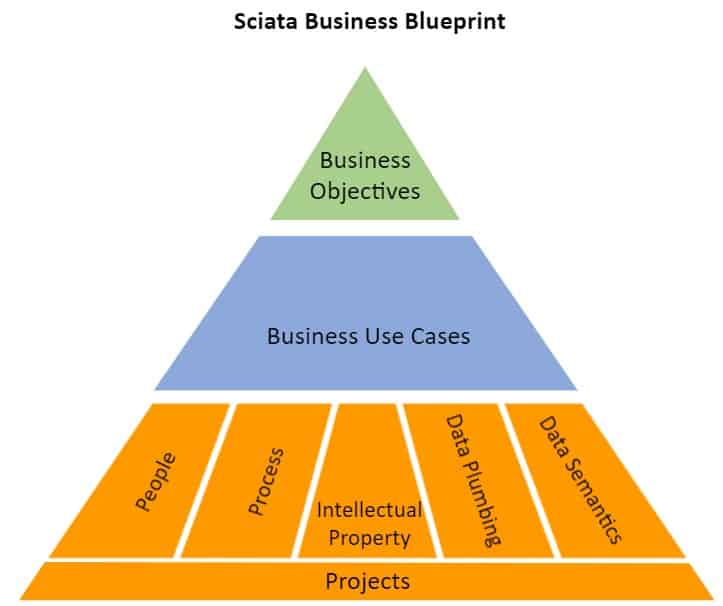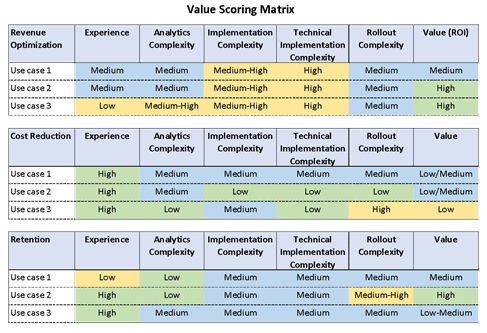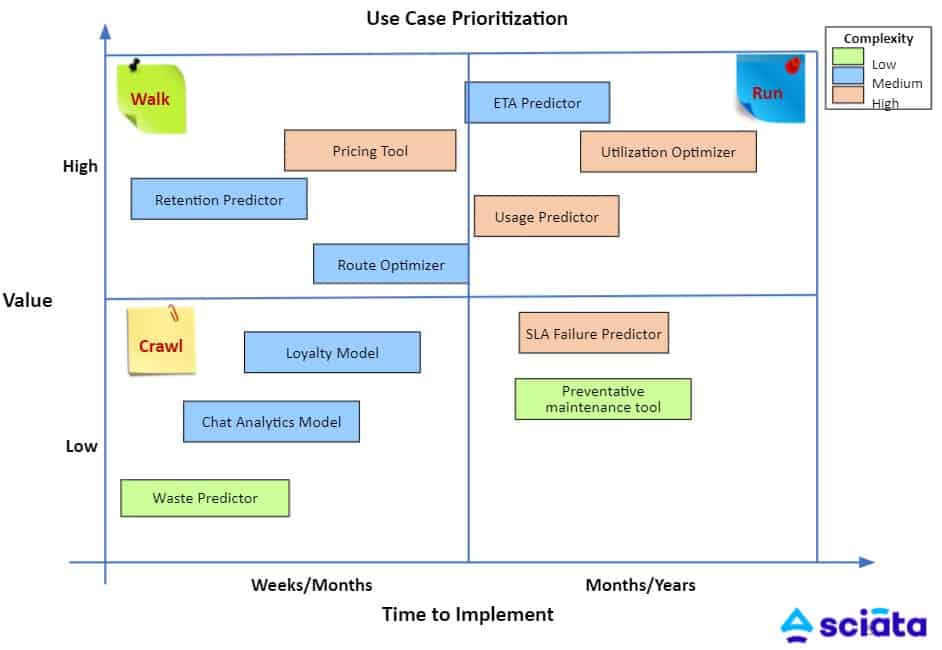“We will first implement a data lake and then prioritize the analytics projects to execute,” said a reputable chief technology officer of a large financial services organization.
What comes first: IT projects or business use cases? I’ve seen this conundrum in several situations. There is a misconception that one takes priority over the other.
According to a survey in a recent Forbes article, 35% of projects failed to meet their original business intent. The business impact of these failures was significant: 50% of respondents said they experienced revenue loss, and 42% reported lower customer satisfaction scores. According to a survey by IAG Consulting, companies with poor business analysis capabilities will have three times as many project failures as successes.
The alignment of IT projects and business use cases is critical. And miscalculating the prioritization and execution of IT and business use cases can lead to catastrophic impacts. IEEE Spectrum highlights several such failures in 2018:
- PSA Airlines, a wholly-owned subsidiary of American Airlines, experienced a problem with its crew scheduling and tracking system that led to nearly 3,000 flights being cancelled over seven days in June. This cost the airline an estimated $35 million. American had brief outages of its own in July and again in November of the same year, both blamed on connectivity issues.
- A botched migration to a new software platform in April at TSB bank in the United Kingdom caused major disruptions for weeks, angered the bank’s 5 million customers and eventually led to the CEO’s resignation.
- The Department of Defense’s new, $4.3 billion MHS Genesis electronic health record was characterized as “operational unsuitable” in initial tests by independent reviewers.
- Amazon suffered glitches for several hours in July when demand exceeded expectations on Prime Day, while several retailers had problems over Black Friday sales days.
And the list goes on. No industry is immune. I’ve seen such failures across large and small companies; having a large IT team only magnifies the challenges.
Back to the original question: What comes first: IT projects or business use cases?
Rather than the sequence of the IT versus business use cases, the key question business executives must ask is: How should you prioritize and align business use cases and IT projects effectively? How should you align priorities across projects? IT is just one component; what are the other critical components for projects to be successful? How do you minimize risk?
In order to determine the right actions and investments, Sciata developed the “Business Blueprint,” a framework that consists of the following key areas:
- Define the business objectives
- Determine and prioritize business use cases
- Launch targeted projects
- Execute
1. Define the business objectives
What are the business objectives? It will be important to quantify them. If the objective is to gain share, how much share and by when? If the objective is to improve operational efficiencies, what aspect of the operations needs to be improved, how much and by when? What are the critical challenges and/or roadblocks? What are the opportunities that can be leveraged? What are the key questions that need to be addressed?
2. Determine and prioritize business use cases
Next, identify the business use cases that can help achieve the business objectives. Determine the key constituents who are critical to providing insight or who can answer the questions defined earlier. Include individuals on the ground experiencing the issues or opportunities on a day-to-day basis. Conduct brainstorming sessions with the constituents and push the team to consider “mild to wild” ideas to get as many ideas on the table.
After identifying all the ideas—group, drop or refine the ideas based on potential use cases that address the business issues at hand. Prioritize the use cases using “value scoring”: score each use case based on estimates of value to the company (ROI), time to implement, level complexity and alignment with core skills.
The level of complexity can be further defined by analytics complexity, IT implementation complexity, difficulty to roll out to the organization, adoption and more, based on relevance to the use cases.
See an example of a value scoring matrix below:
Plot the use cases along a 2×2 matrix with value or ROI on one axis and time to implement on the other axis, and highlight the complexity of the use cases. A low risk “crawl, walk, run” approach would start with low or medium complexity use cases on the bottom left quadrant and move to the top right approach as you begin securing the ROI that could fund subsequent projects.
3. Launch targeted projects
Once you’ve prioritized the use cases, define the projects that would enable them. Below are five categories to consider for defining the projects along with a few sample questions you need to address within each category.
People: Start by determining the key people who should work on the projects. Do they have the right skills and experience? Do you have representation from the right departments? Do you have customer and channel perspectives represented? Is the IT department represented? Who will be accountable to the successful completion of the project objectives? Does each project have an executive champion to clear roadblocks quickly?
Process: It is important to understand the current process before making any changes. What is the current workflow? What are the inhibitors? What is the time scale across the different steps? How many touchpoints exist across customers and partners, and across functions or departments? What are the costs and impacts? Once the current process is defined, you can start outlining alternative “to be” processes for assessment.
Intellectual Property: What would differentiate your use case or approach from competitors’? Is there any intellectual property that can be developed,or any existing intellectual property that can be applied to differentiate? What drives customer satisfaction?
Data Plumbing: What are the supporting IT infrastructure requirements for the use case? How will data be extracted from the systems? How will it be cleaned, transformed and catalogued? How do you extract information from unstructured data (pictures and jpeg files)? Do you need to build a data lake? Do you need a cloud-based infrastructure? What systems need to be integrated? What are the performance requirements and supporting technology requirements?
Data Semantics: Once you have the data, how will you secure insights from the data? Do you have sufficient data to uncover patterns and insights? What are the desired outcomes? What are the Key Performance Indicators (KPIs)? Do you have the right KPIs and potential predictors in order to predict desired outcomes? What algorithms (Artificial Intelligence, Machine Learning, Deep Learning, Computer Vision, etc.) would provide the best tools for the outcomes?
Identify the dependencies across these elements, particularly across data plumbing and data semantics, and determine the best tradeoffs of speed versus accuracy.
In one client example, there was sufficient data available to secure quick initial insights that could be strengthened and enhanced with more data. The client decided to develop the initial predictive models with the available data and in parallel began implementing the data infrastructure to build out the robustness and capabilities of the use case over time.
In another example, a healthcare client prioritized two specific business use cases around medical diagnostics and customer loyalty. Based on these priorities, the client implemented a data lake while prioritizing the data stores that were critical for these two use cases.
4. Execute
An effective management system is critical to ensure that the project is progressing well to achieve desired results. Do you have the right process and metrics in place to get visibility to project execution? Do you have the right project management approach for the project? Is there a steering committee structure in place to monitor and guide the project towards results? Do you have the right individuals and skills on the core team? Are the right executives and individuals on the steering committee and core team?
To return to the original question, what comes first: IT projects or business use cases? The answer is clear: “It depends.” It depends on the business objectives, prioritization of use cases, people, process, and the dependencies across data plumbing and data semantics. It is more critical that all these elements are aligned to achieve the business objectives quickly.
Sciata’s Business Blueprint is a framework that will help improve the odds of success by defining critical elements of projects, aligning the projects with the use cases and ensuring the use cases are prioritized to achieve the business objectives.
* * *
This is the second white paper in Pragmatic Institute’s series by Sciata President Harish Krishnamurthy on ensuring ROI from artificial intelligence, transforming insights into action, and driving a cultural change in how your organization leverages data. Read the first piece, 1) “Making the Leap from AI Investments to Business Results,” and the subsequent ones, 3) “Using AI to Maximize Customer Lifetime Value,” 4) “Designing AI Models to Extract Insights,” 5) “Transforming AI Insights into Actions.”
Learn how Pragmatic Institute can train your data team to deliver critical insights that power business strategy.
Author
-

Harish Krishnamurthy, with 36 years of expertise in data, has held pivotal roles at Honeywell, McKinsey & Company, A.T. Kearney, IBM, Insight, Spear Education, Sciata, and Pragmatic Institute. With leadership spanning P&L, sales, marketing, and strategy, he has made significant contributions to the field. For questions or inquiries, please contact [email protected].
View all posts













